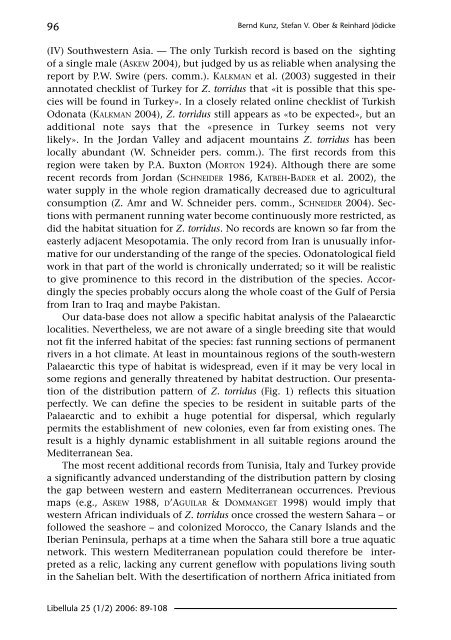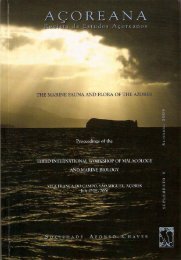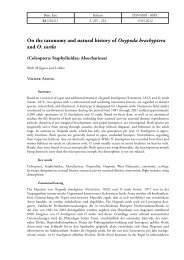The distribution of Zygonyx torridus in the Palaearctic (Odonata ...
The distribution of Zygonyx torridus in the Palaearctic (Odonata ...
The distribution of Zygonyx torridus in the Palaearctic (Odonata ...
Create successful ePaper yourself
Turn your PDF publications into a flip-book with our unique Google optimized e-Paper software.
96<br />
Libellula 25 (1/2) 2006: 89-108<br />
Bernd Kunz, Stefan V. Ober & Re<strong>in</strong>hard Jödicke<br />
(IV) Southwestern Asia. — <strong>The</strong> only Turkish record is based on <strong>the</strong> sight<strong>in</strong>g<br />
<strong>of</strong> a s<strong>in</strong>gle male (ASKEW 2004), but judged by us as reliable when analys<strong>in</strong>g <strong>the</strong><br />
report by P.W. Swire (pers. comm.). KALKMAN et al. (2003) suggested <strong>in</strong> <strong>the</strong>ir<br />
annotated checklist <strong>of</strong> Turkey for Z. <strong>torridus</strong> that «it is possible that this species<br />
will be found <strong>in</strong> Turkey». In a closely related onl<strong>in</strong>e checklist <strong>of</strong> Turkish<br />
<strong>Odonata</strong> (KALKMAN 2004), Z. <strong>torridus</strong> still appears as «to be expected», but an<br />
additional note says that <strong>the</strong> «presence <strong>in</strong> Turkey seems not very<br />
likely». In <strong>the</strong> Jordan Valley and adjacent mounta<strong>in</strong>s Z. <strong>torridus</strong> has been<br />
locally abundant (W. Schneider pers. comm.). <strong>The</strong> first records from this<br />
region were taken by P.A. Buxton (MORTON 1924). Although <strong>the</strong>re are some<br />
recent records from Jordan (SCHNEIDER 1986, KATBEH-BADER et al. 2002), <strong>the</strong><br />
water supply <strong>in</strong> <strong>the</strong> whole region dramatically decreased due to agricultural<br />
consumption (Z. Amr and W. Schneider pers. comm., SCHNEIDER 2004). Sections<br />
with permanent runn<strong>in</strong>g water become cont<strong>in</strong>uously more restricted, as<br />
did <strong>the</strong> habitat situation for Z. <strong>torridus</strong>. No records are known so far from <strong>the</strong><br />
easterly adjacent Mesopotamia. <strong>The</strong> only record from Iran is unusually <strong>in</strong>formative<br />
for our understand<strong>in</strong>g <strong>of</strong> <strong>the</strong> range <strong>of</strong> <strong>the</strong> species. Odonatological field<br />
work <strong>in</strong> that part <strong>of</strong> <strong>the</strong> world is chronically underrated; so it will be realistic<br />
to give prom<strong>in</strong>ence to this record <strong>in</strong> <strong>the</strong> <strong>distribution</strong> <strong>of</strong> <strong>the</strong> species. Accord<strong>in</strong>gly<br />
<strong>the</strong> species probably occurs along <strong>the</strong> whole coast <strong>of</strong> <strong>the</strong> Gulf <strong>of</strong> Persia<br />
from Iran to Iraq and maybe Pakistan.<br />
Our data-base does not allow a specific habitat analysis <strong>of</strong> <strong>the</strong> <strong>Palaearctic</strong><br />
localities. Never<strong>the</strong>less, we are not aware <strong>of</strong> a s<strong>in</strong>gle breed<strong>in</strong>g site that would<br />
not fit <strong>the</strong> <strong>in</strong>ferred habitat <strong>of</strong> <strong>the</strong> species: fast runn<strong>in</strong>g sections <strong>of</strong> permanent<br />
rivers <strong>in</strong> a hot climate. At least <strong>in</strong> mounta<strong>in</strong>ous regions <strong>of</strong> <strong>the</strong> south-western<br />
<strong>Palaearctic</strong> this type <strong>of</strong> habitat is widespread, even if it may be very local <strong>in</strong><br />
some regions and generally threatened by habitat destruction. Our presentation<br />
<strong>of</strong> <strong>the</strong> <strong>distribution</strong> pattern <strong>of</strong> Z. <strong>torridus</strong> (Fig. 1) reflects this situation<br />
perfectly. We can def<strong>in</strong>e <strong>the</strong> species to be resident <strong>in</strong> suitable parts <strong>of</strong> <strong>the</strong><br />
<strong>Palaearctic</strong> and to exhibit a huge potential for dispersal, which regularly<br />
permits <strong>the</strong> establishment <strong>of</strong> new colonies, even far from exist<strong>in</strong>g ones. <strong>The</strong><br />
result is a highly dynamic establishment <strong>in</strong> all suitable regions around <strong>the</strong><br />
Mediterranean Sea.<br />
<strong>The</strong> most recent additional records from Tunisia, Italy and Turkey provide<br />
a significantly advanced understand<strong>in</strong>g <strong>of</strong> <strong>the</strong> <strong>distribution</strong> pattern by clos<strong>in</strong>g<br />
<strong>the</strong> gap between western and eastern Mediterranean occurrences. Previous<br />
maps (e.g., ASKEW 1988, D’AGUILAR & DOMMANGET 1998) would imply that<br />
western African <strong>in</strong>dividuals <strong>of</strong> Z. <strong>torridus</strong> once crossed <strong>the</strong> western Sahara – or<br />
followed <strong>the</strong> seashore – and colonized Morocco, <strong>the</strong> Canary Islands and <strong>the</strong><br />
Iberian Pen<strong>in</strong>sula, perhaps at a time when <strong>the</strong> Sahara still bore a true aquatic<br />
network. This western Mediterranean population could <strong>the</strong>refore be <strong>in</strong>terpreted<br />
as a relic, lack<strong>in</strong>g any current geneflow with populations liv<strong>in</strong>g south<br />
<strong>in</strong> <strong>the</strong> Sahelian belt. With <strong>the</strong> desertification <strong>of</strong> nor<strong>the</strong>rn Africa <strong>in</strong>itiated from
















